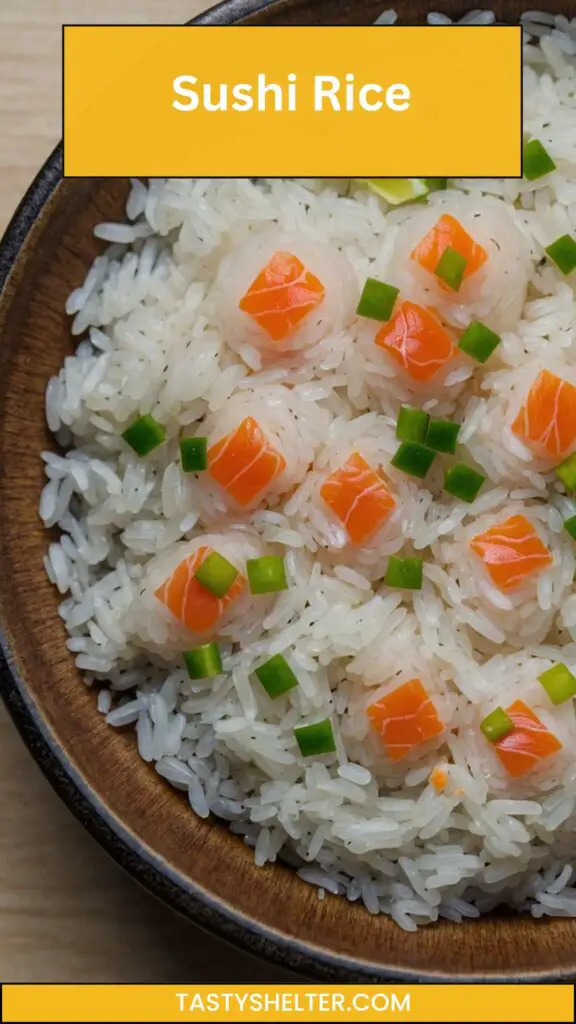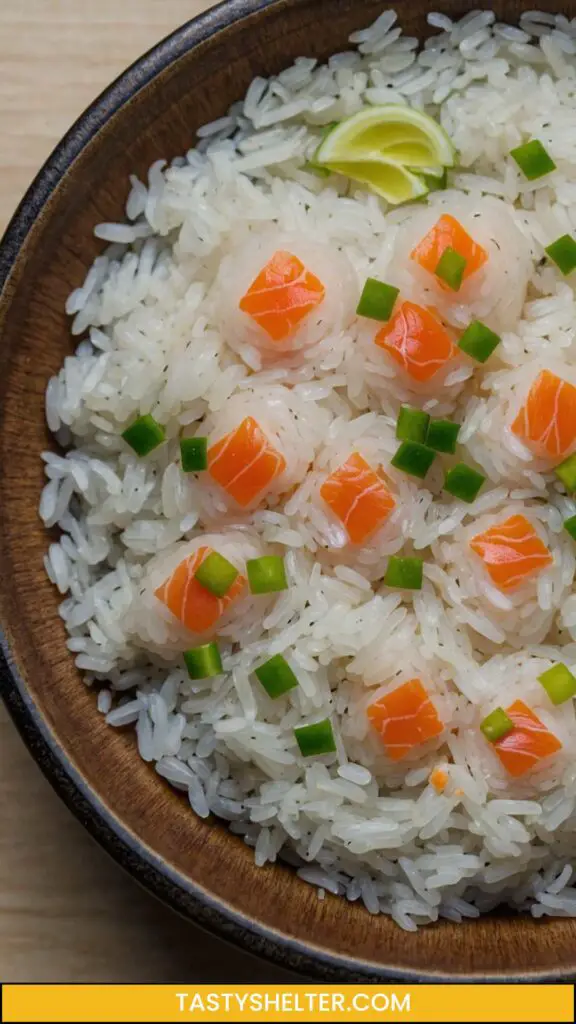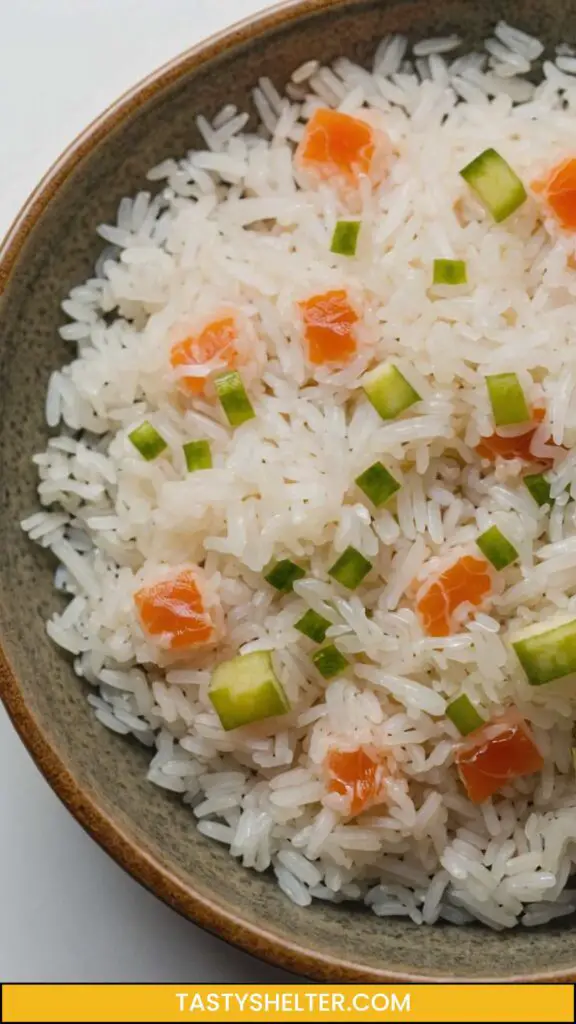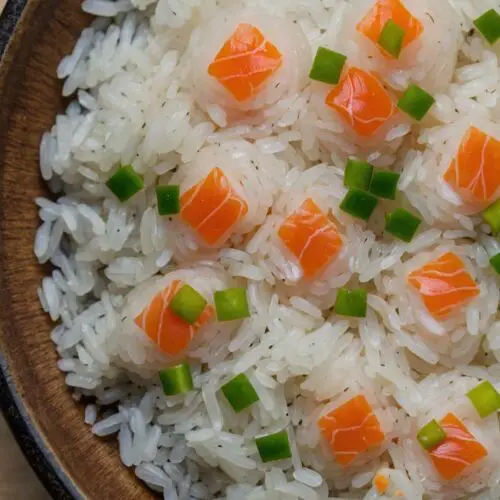I have a confession. Sushi rice is my guilty pleasure. When I think of sushi, I don’t just picture raw fish (though I love that too), but the essential ingredient that holds it all together – sushi rice. This dish pairs beautifully with various toppings and can elevate any meal to new heights.
Today, I’m excited to take you on a journey through the world of sushi rice. We’ll explore what makes it unique, discuss recipes, and unravel the simple steps to make this essential component from scratch.

Sushi rice doesn’t get the spotlight it deserves. It complements fish, vegetables, and even fruits in an incredible way. This sticky, slightly sweet rice binds flavors and textures harmoniously. You see, sushi rice isn’t just a sidekick; it’s a star in its own right. When prepared correctly, it can make or break your sushi experience.
During my culinary explorations, I’ve learned that sushi is much more than a type of food. It’s an art form. Each ingredient plays a significant role, and sushi rice sets the stage for the masterpiece. The right consistency and the perfect taste can transform a dish from ordinary to extraordinary.
Well, you might be curious, what exactly is sushi rice?
You Might Also Like These Recipes!
What is Sushi Rice?
Sushi rice, or “shari,” is short-grain rice that has a higher starch content, which contributes to its characteristic stickiness when cooked. It’s seasoned with a combination of rice vinegar, sugar, and salt after cooking, giving it a subtly sweet taste.
Not all rice will do. While many might try to use long-grain rice or jasmine, they lack the essential qualities that make sushi rice unique. When you bite into a piece of sushi, you expect that slight chewiness and a delicate sweetness, right? That’s sushi rice doing its job beautifully.
Why This Recipe Works
So why should you trust my sushi rice recipe? Well, here are a few solid reasons:
1. Perfect Balance of Flavor:
The combination of seasoned rice with ingredients like rice vinegar and sugar creates a delicate balance. This harmony enhances whatever filling or topping you choose.
2. Simple Yet Effective Method:
Making sushi rice is straightforward. You don’t need advanced culinary skills to create something delicious. With just a few ingredients and some patience, you’re on your way to sushi heaven.
3. Versatile Applications:
You can use sushi rice for more than just sushi rolls. Think of sushi rice as a base for poke bowls, or even as a unique side dish to complement grilled meats or roasted vegetables.
4. Budget-Friendly Ingredients:
You don’t need gourmet shops to gather supplies. Most of the ingredients can be found at your local grocery store. They might not be fancy, but they’ll deliver tastiness without putting a dent in your wallet.
Ingredients You’ll Need To Make This Sushi Rice
Gathering the right ingredients sets the foundation for your success. Here’s what you’ll need:
- 2 cups Japanese short-grain rice (sushi rice), rinsed well
- 1 teaspoon fine sea salt
- 4 teaspoons natural cane sugar (or honey)
- 1/4 cup plain rice vinegar (unseasoned)
- 2 cups filtered water
- 1 teaspoon mirin (optional for sweetness)
- 1/2 teaspoon toasted sesame oil (optional for flavor)
- 1 small piece of dried kombu (optional, for umami depth)
The optional ingredients can add a depth of flavor that enhances the overall experience.

How to Make Sushi Rice?
Now let’s dive into the steps of preparing this delightful dish. It’s easier than you think!
Step 1: Rinse the Rice
Start by rinsing the sushi rice under cold water. Rinse until the water runs clear to remove excess starch. This is an essential step; it helps achieve the right texture and prevents the rice from becoming overly sticky.
Step 2: Soak the Rice
After rinsing, soak the rice in water for about 30 minutes in a medium bowl. This allows the grains to absorb water before cooking, leading to fluffier rice.
Step 3: Cook the Rice
Combine the soaked rice and 2 cups of filtered water in a rice cooker or a saucepan. If using a saucepan, bring it to a boil over medium-high heat. Once boiling, reduce the heat to low and cover the pan. Let it simmer for about 15 minutes.
For a rice cooker, follow the manufacturer’s instructions. Generally, a standard setting will do the trick for sushi rice.
Step 4: Prepare the Seasoning
While the rice cooks, combine the rice vinegar, natural cane sugar, salt, and optional mirin in a small saucepan. Heat gently over low heat until the sugar dissolves, stirring occasionally. Don’t boil it; you just want everything to blend beautifully.
Step 5: Mix Everything Together
Once the rice has cooked, transfer it to a large bowl (a wooden or non-stick bowl works best). Pour the vinegar mixture over the hot rice. Using a wooden spatula or paddle, gently fold the rice, handling it with care. You want to avoid squishing the grains but ensure seasoning coverage.
Step 6: Cool the Rice
As you mix, fan the rice with a piece of cardboard or a hand fan. This helps cool the rice and gives it a slight sheen. Aim for room temperature before using it in your sushi.
Tips for Sushi Rice Success
Crafting sushi rice isn’t just about following a recipe. Here are five tips to help you ace your sushi rice:
Rinse Thoroughly: Don’t skip rinsing the rice. Proper rinsing is essential. It prevents clumping and ensures that delicate texture we’re after.
Use the Right Vinegar: Using plain rice vinegar is important as it has the mild flavor needed for sushi rice. Avoid flavored varieties unless you’re ready for a taste twist.
Don’t Rush the Cooling: Allow the rice to cool naturally. This step is crucial for achieving the perfect sticky consistency necessary for rolling sushi.
Experiment with Proportions: Feel free to adjust the amount of sugar or vinegar based on your personal taste. Some like it sweeter, while others prefer it more tangy.
Make in Advance: Sushi rice can be made a few hours ahead. Just cover it with a damp cloth to keep it moist until you’re ready to use it.
Nutrition Information
Curious about the nutrition of sushi rice? Here’s a general breakdown (for a 1-cup serving):
- Calories: 300
- Carbohydrates: 65g
- Protein: 6g
- Fat: 1g
- Fiber: 1g
Keep in mind, nutrition can vary depending on the specific ingredients and quantities used in your specific sushi dish.

How to Store the Leftovers?
Leftover sushi rice can be tricky, but here’s how to store it properly. Allow it to cool completely, then transfer it to an airtight container. It can be kept in the refrigerator for up to 3 days. When you’re ready to use it again, consider reheating it gently in the microwave with a splash of water to regain moisture.
Recommended Side Dishes for Sushi Rice
Sushi rice is incredibly versatile, and there are numerous delicious side dishes that can complement it beautifully. Here are four suggestions you might enjoy:
1. Edamame:
These young soybeans are not only fun to eat but packed with protein. Toss them with sea salt for added flavor.
2. Miso Soup:
A warm bowl of miso soup offers a comforting pairing that balances the texture and taste of sushi rolls.
3. Seaweed Salad:
Bright and tangy, seaweed salad provides a refreshing contrast to sushi rice. The umami from the seaweed elevates the entire meal.
4. Pickled Vegetables:
Marinated cucumber or pickled radishes can add a crispy crunch that’s a great counterpoint to the soft texture of the rice.
Substitute Options for Ingredients
Not every kitchen has sushi rice or the specific ingredients on hand. If you find yourself short, here are some substitutes that can still produce a tasty result:
1. Short-Grain Brown Rice:
If you can’t find sushi rice, short-grain brown rice can work as a healthier alternative. It offers a nuttier flavor and chewy texture.
2. Apple Cider Vinegar:
In case rice vinegar is out of stock, apple cider vinegar is a handy substitute. Just know that it will be slightly sweeter and more robust in flavor.
3. Agave Syrup:
If you don’t have natural cane sugar, agave syrup can step in with a similar sweetness, but you may need to adjust the amount.
4. Kombucha Tea:
In place of mirin, you can use a splash of kombucha. This will add a tangy touch that can replicate some of that sweet flavor.

Sushi Rice
Equipment
- saucepan
Ingredients
- 2 cups Japanese short-grain rice sushi rice, rinsed well
- 1 teaspoon fine sea salt
- 4 teaspoons natural cane sugar or honey
- 1/4 cup plain rice vinegar unseasoned
- 2 cups filtered water
- 1 teaspoon mirin optional for sweetness
- 1/2 teaspoon toasted sesame oil optional for flavor
- 1 small piece of dried kombu optional, for umami depth
Instructions
- Now let’s dive into the steps of preparing this delightful dish. It’s easier than you think!
Step 1: Rinse the Rice
- Start by rinsing the sushi rice under cold water. Rinse until the water runs clear to remove excess starch. This is an essential step; it helps achieve the right texture and prevents the rice from becoming overly sticky.
Step 2: Soak the Rice
- After rinsing, soak the rice in water for about 30 minutes in a medium bowl. This allows the grains to absorb water before cooking, leading to fluffier rice.
Step 3: Cook the Rice
- Combine the soaked rice and 2 cups of filtered water in a rice cooker or a saucepan. If using a saucepan, bring it to a boil over medium-high heat. Once boiling, reduce the heat to low and cover the pan. Let it simmer for about 15 minutes.
- For a rice cooker, follow the manufacturer’s instructions. Generally, a standard setting will do the trick for sushi rice.
Step 4: Prepare the Seasoning
- While the rice cooks, combine the rice vinegar, natural cane sugar, salt, and optional mirin in a small saucepan. Heat gently over low heat until the sugar dissolves, stirring occasionally. Don’t boil it; you just want everything to blend beautifully.
Step 5: Mix Everything Together
- Once the rice has cooked, transfer it to a large bowl (a wooden or non-stick bowl works best). Pour the vinegar mixture over the hot rice. Using a wooden spatula or paddle, gently fold the rice, handling it with care. You want to avoid squishing the grains but ensure seasoning coverage.
Step 6: Cool the Rice
- As you mix, fan the rice with a piece of cardboard or a hand fan. This helps cool the rice and gives it a slight sheen. Aim for room temperature before using it in your sushi.
Notes
Frequently Asked Questions
1. Can I use regular rice for sushi?
No, regular rice does not have the same starch content needed for sushi rice. It won’t produce the desired sticky texture.
2. Why is sushi rice sweet?
The sugar added to the rice vinegar mixture provides a gentleness that balances the overall flavor profile, complementing the savory toppings.
3. Can sushi rice be frozen?
Yes, sushi rice can be frozen. Spread it out on a baking sheet to cool, then store it in a freezer-safe bag or container. It’s best to use it within a month for optimal quality.
4. How important is the vinegar for sushi rice?
It’s quite significant! The vinegar not only flavors the rice but also helps to preserve it. Using the right balance is key for an authentic experience.
5. Can I make sushi rice without sugar?
Yes, you can omit sugar if you prefer. However, this will alter the flavor profile. You might want to increase the amount of vinegar or add a natural sweetener instead.
Conclusion
In conclusion, sushi rice is not just an ingredient; it’s a cornerstone of sushi culture. Whether you’re rolling your creations at home or indulging at a sushi restaurant, the quality and preparation of the rice are paramount. With the right ingredients, a few simple steps, and some personal touches, you can master sushi rice like a pro.
So roll up your sleeves and bring a little slice of Japan to your kitchen. Sushi rice is an adventure waiting to happen, and I can’t wait for you to taste the results. Who knows? You might find yourself hosting your sushi night soon enough!




